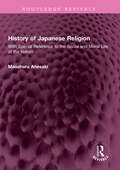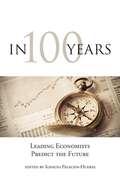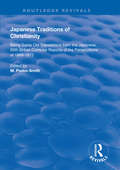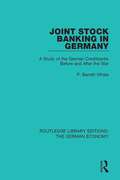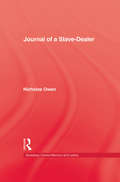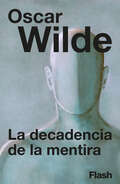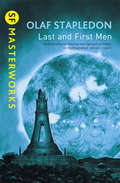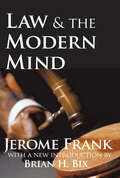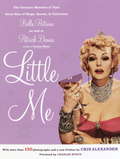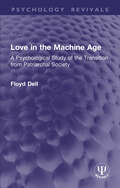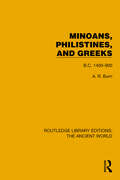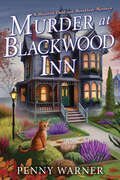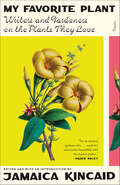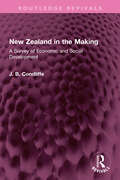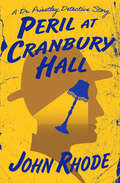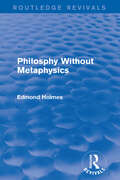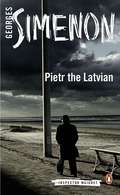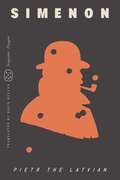- Table View
- List View
History of Japanese Religion: With Special Reference to the Social and Moral Life of the Nation (Routledge Revivals)
by Masaharu AnesakiFirst Published in 1930, History of Japanese Religion shows the interaction of various forces which manifested their vitality more in combination than in opposition. A saying ascribed to Prince Shotoku, the founder of Japanese civilization, compares the three religious and moral systems found in Japan to the root, the stem and branches, and the flowers and fruits of a tree. Shinto is the root embedded in the soil of the people's character and national traditions; Confucianism is seen in the stem and branches of legal institutions, ethical codes, and educational systems; Buddhism made the flowers of religious sentiment bloom and gave the fruits of spiritual life. These sentences outlines the scheme of the work and achievement that has long maintained a high reputation among students and scholars. This important and frequently cited book has been out of print for many decades and thus increasingly difficult to access. It is therefore a privilege as well as a pleasure to make it available once again in a complete and unabridged reprint of the original. This is a must read for students of religion, Japanese culture and Japanese history.
In 100 Years
by Ignacio Palacios-HuertaThis pithy and engaging volume shows that economists may be better equipped to predict the future than science fiction writers. Economists' ideas, based on both theory and practice, reflect their knowledge of the laws of human interactions as well as years of experimentation and reflection. Although perhaps not as screenplay-ready as a work of fiction, these economists' predictions are ready for their close-ups. In this book, ten prominent economists -- including Nobel laureates and several likely laureates -- offer their ideas about the world of the twenty-second century. In scenarios that range from the optimistic to the guardedly gloomy, these thinkers consider such topics as the transformation of work and wages, the continuing increase in inequality, the economic rise of China and India, the endlessly repeating cycle of crisis and (projected) recovery, the benefits of technology, the economic consequences of political extremism, and the long-range effects of climate change. For example, Daron Acemoglu offers a thoughtful discussion of how trends of the last century -- including uneven growth, technological integration, and resource scarcity -- might translate into the next; 2013 Nobelist Robert Shiller provides an innovative view of future risk management methods using information technology; 2012 Nobelist Alvin Roth projects his theory of Matching Markets into the next century, focusing on schools, jobs, marriage and family, and medicine; 1987 Nobelist Robert Solow considers the shift away from remunerated labor, among other subjects; and Martin Weitzman raises the intriguing but alarming possibility of using geoengineering techniques to mitigate the nevitable effects of climate change. In a 1930 essay mentioned by several contributors, "Economic Possibilities for Our Grandchildren," John Maynard Keynes offered predictions that, read today, range from absolutely correct to spectacularly wrong. This book follows in Keynes's path, hoping, perhaps, to better his average.
Instituting Nature
by Andrew S. MathewsGreater knowledge and transparency are often promoted as the keys to solving a wide array of governance problems. In Instituting Nature, Andrew Mathews describes Mexico's efforts over the past hundred years to manage its forests through forestry science and biodiversity conservation. He shows that transparent knowledge was produced not by official declarations or scientists' expertise but by encounters between the relatively weak forestry bureaucracy and the indigenous people who manage and own the pine forests of Mexico. Mathews charts the performances, collusions, complicities, and evasions that characterize the forestry bureaucracy. He shows that the authority of forestry officials is undermined by the tension between local realities and national policy; officials must juggle sweeping knowledge claims and mundane concealments, ambitious regulations and routine rule breaking. Moving from government offices in Mexico City to forests in the state of Oaxaca, Mathews describes how the science of forestry and bureaucratic practices came to Oaxaca in the 1930s and how local environmental and political contexts set the stage for local resistance. He tells how the indigenous Zapotec people learned the theory and practice of industrial forestry as employees and then put these skills to use when they become the owners and managers of the area's pine forests--eventually incorporating forestry into their successful claims for autonomy from the state. Despite the apparently small scale and local contexts of this balancing act between the power of forestry regulations and the resistance of indigenous communities, Mathews shows that it has large implications--for how we understand the modern state, scientific knowledge, and power and for the global carbon markets for which Mexican forests might become valuable.
It Wasn't Love
by Denise RobinsLois had been warned about shipboard romances, but felt herself quite immune as she set out to visit her brother in Singapore.But Philip Sanpell seemed to be something quite different. His stunning good looks and passionate kisses made her throw caution to the wind, and before the end of the voyage her heart was irretrievably lost.But it wasn't long before she remembered those warnings and, with bitter regret, her own heedlessness...A captivating love story from the 100-million-copy bestselling Queen of Romance, first published in 1930, and available now for the first time in eBook.
Japanese Traditions of Christianity (Routledge Revivals)
by M Paske-SmithPublished in 1930, this book traces the long history of Christianity in Japan. Paske-Smith details the journey of the early missionaries from the west, the conflict that arose from the introduction of Christianity to Japan and how Christianity’s influence transformed some of the Japanese cultural landscape.
Joint Stock Banking in Germany: A Study of the German Creditbanks Before and After the War (Routledge Library Editions: The German Economy #13)
by P Barrett WhaleThis classic study of German creditbanks was first published in 1930 and even now deserves its place as a fundamental text on banking in Germany. It is a valuable comparative study of one important type of financial institution and represents a detailed survey of Joint Stock Banking in Germany in the pre-war, war and post-war periods upt o 1928.
Journal Of A Slave-Dealer: A Living History of the Slave Trade
by OwenOriginally published in 1930, this volume documents the years 1746-1757 from the perspective of an Irish slave-dealer, Nicholas Owen, travelling between Africa and America.
La decadencia de la mentira
by Oscar WildeUna defensa del arte por el arte clave para descubrir el pensamiento y la estética de Oscar Wilde. El arte ha caído en la cárcel del realismo y ha perdido toda la libertad creativa. Y, para huir de este culto a los hechos, es necesario reivindicar el papel de la mentira y el artificio en las obras. Mediante un diálogo repleto de paradojas y de la ironía característica del autor, Oscar Wilde evidencia la necesidad de escapar de toda intención moralizadora en la obra artística. Puesto que no hay nada más real que el arte, este debe existir por sí mismo y evitar ser un reflejo de una realidad que no haría más que corromperlo. «Oscar Wilde tiene el poder de transformar el ensayo en ficción.» Luis Antonio De Villen
Last And First Men (S.F. MASTERWORKS)
by Olaf StapledonOne of the most extraordinary, imaginative and ambitious novels of the century: a history of the evolution of humankind over the next 2 billion years.Among all science fiction writers Olaf Stapledon stands alone for the sheer scope and ambition of his work. First published in 1930, Last and First Men is full of pioneering speculations about evolution, terraforming, genetic engineering and many other subjects.
Last And First Men: A Story Of The Near And Far Future (S. F. Masterworks Ser. #No.11)
by Olaf StapledonOne of the most extraordinary, imaginative and ambitious novels of the century: a history of the evolution of humankind over the next 2 billion years.Among all science fiction writers Olaf Stapledon stands alone for the sheer scope and ambition of his work. First published in 1930, Last and First Men is full of pioneering speculations about evolution, terraforming, genetic engineering and many other subjects.
Law and the Modern Mind
by Brian H. Bix Jerome FrankLaw and the Modern Mind first appeared in 1930 when, in the words of Judge Charles E. Clark, it "fell like a bomb on the legal world." In the generations since, its influence has grown-today it is accepted as a classic of general jurisprudence.The work is a bold and persuasive attack on the delusion that the law is a bastion of predictable and logical action. Jerome Frank's controversial thesis is that the decisions made by judge and jury are determined to an enormous extent by powerful, concealed, and highly idiosyncratic psychological prejudices that these decision-makers bring to the courtroom.
Little Me
by Patrick DennisBack in print at last! From the author of Auntie Mame: the bawdy, bestselling, bountifully illustrated autobiography of an imaginary diva whose life is one hilarious mishap after another.For Belle Poitrine, née Mayble Schlumpfert, all the world's a stage and she's the most important player on it. At once coy and coercive, with a name that means "beautiful bosom" in French, she claws her way from Striver's Row to the silver screen. Recalling Belle's career, which ranged from portraying Anne Boleyn in Oh, Henry to roles in both Sodom and its sequel Gomorrah (not to mention the classic Papaya Paradise), Little Me serves up copious quanitites of husbands, couture, and Pink Lady cocktails, with international adventures and a murder trial to boot.A runaway bestseller that made its way to Broadway, starring Sid Caesar in 1962 and Martin Short in 1998, Little Me is now reprinted--with all of the 150 historic, hysterical photographs depicting the funniest scenes from Belle's sordid life, including cameo appearances by the author and Rosalind Russell. Considered a collector's item, the first edition of Little Me was like a performance in book form. Now this glittering spoof of celebrity is gloriously reincarnated for connoisseurs of all things chick and cheeky.From the Trade Paperback edition.
Love in the Machine Age: A Psychological Study of the Transition from Patriarchal Society (Psychology Revivals)
by Floyd DellFirst published in 1930, the object of Love in the Machine Age was to popularize a modern and scientific view of behavior, and thereby help people to live happy and successful lives. The author traces in popular language for the time, the break-up of the patriarchal values held by most of society, and points out from the standpoint of modern psychiatric knowledge the inevitable effects upon sexual mores, personality adjustments and the growth of children. Topics covered include marriage, parenting, adolescence, with special emphasis paid to the “mating problems” of youth. Taking its lead from psychological theories prevalent at the time, today it can be read in its historical context.This book is a re-issue originally published in 1930. The language used and views portrayed are a reflection of its era and no offence is meant by the Publishers to any reader by this re-publication.
Minoans, Philistines and Greeks: B.C. 1400–900 (Routledge Library Editions: The Ancient World)
by Andrew Robert BurnMinoans, Philistines, and Greeks (1930) presents a historical narrative of the fortunes of the Aegean people, including invaders of and fugitives from the Aegean area, from the end of the fifteenth to the end of the tenth century B.C. It traces the gradual decline and fall of the Aegean culture, the first advanced civilisation in Europe, and the migrations of peoples such as the Philistines and Phoenicians across the Mediterranean.
Murder at Blackwood Inn: A Haunted Dead and Breakfast Mystery (A Haunted Dead and Breakfast Mystery)
by Penny WarnerA haunted house and the occult are the least of Carissa Blackwood&’s problems when her eccentric aunts are accused of murder in this cozy series debut by multiple award–winning author Penny Warner.Ghostwriter Carissa Blackwood is having the worst year of her life. After leaving her cheating husband, she finally takes up the offer to help her two eccentric aunts manage the Blackwood Bed &’n&’ Breakfast Inn in Pelican Point, California–a house they only recently inherited from their deceased father, Bram Blackwood. The old man dabbled in the occult, and his daughters haven&’t fallen far from the family tree. Aunt Runa is into crystals and plans to hold séances at the reportedly &“haunted&” house. Aunt Hazel has an herbary and offers herbal cures for everything from headaches to paranormal visions. But it&’s Hazel&’s poison garden that really concerns Carissa. When one of the townspeople dies from a poison that could have only come from Aunt Hazel&’s garden, the town is quick to point fingers. It doesn&’t help that one of Aunt Runa&’s charms is found at the scene of the crime. With a little help from Noah, the mysterious and handsome handyman; Aiden, the charming newspaperman—and the ghost of Carissa&’s grandfather—it&’s up to Carissa to clear her aunts and find the real killer before someone else is checked out for good at the B&B.
My Favorite Plant: Writers and Gardeners on the Plants They Love
by Jamaica KincaidA delightful compendium of writing on plants.The passion for gardening and the passion for words come together in this inspired anthology, a collection of essays on topics as diverse as beans and roses, by writers who garden and by gardeners who write. Among the contributors are Christopher Lloyd, on poppies; Marina Warner, who remembers the Guinée rose; and Henri Cole, who offers poems on the bearded iris and on peonies. There is also an explanation of the sexiness of castor beans from Michael Pollan and an essay from Maxine Kumin on how, as Henry David Thoreau put it, one "[makes] the earth say beans instead of grass." Most of the essays are new in print, but Colette, Katharine S. White, D. H. Lawrence, and several other old favorites make appearances. Jamaica Kincaid, the much-admired writer and a passionate gardener herself, rounds up this diverse crew. A wonderful gift for green thumbs, My Favorite Plant is a happy collection of fresh takes on old friends.Other contributors include: Hilton Als Mary KeenKen Druse Duane MichalsMichael Fox David RaffeldIan Frazier Graham Stuart ThomasDaniel Hinkley Wayne Winterrowd
Nathaniel Clark Smith: Pioneer American Music Educator
by Dr Eva Diane Lyle-SmithIf you are interested in learning about a pioneer African American music educator in the United States, then you want to read the story of Nathaniel Clark Smith. Smith was a prolific and charismatic music educator, musician, and composer who lived during the early years of music education history in the United States. His formal training in music was on a military base in Ft. Leavenworth, KS. Extended studies were from Guild Hall in London, England. A college graduate with B.M.A. and M.M degrees, Smith taught music in educational institutions and industries; was a world traveller who performed with the Ernest Hogan Minstrel Troupe; introduced the saxophone to African Americans; composed and published spirituals, marches, operatic songs, a suite, and an unfinished symphony; and hosted a radio broadcast show which was aired all over the Mid-West. He organized bands and out of that, orchestras, choirs, glee clubs and numerous combinations of the voice and instruments were developed. Smith captured the melodies of the countries that he visited in his music compositions.During his illustrious career, Smith worked with Frederick Douglas, Paul Lawrence Dunbar, Booker T. Washington, Nat King Cole, Lionel Hampton, Milton Hinton, John Phillip Sousa, a young Charlie Parker, and others. His students from the Lincoln High School Band became the nucleus of the big band format of the Mid-West. His Pullman Porter musicians were able to perform at a moment&’s notice.Married with one daughter and the son of an African Sergeant Trumpeter and Indian mother, The Story of Nathaniel Clark Smith is a colourful reading of the times during abolition to the mid depression years in the United States. It is the story of an African-American who survived the challenges of the time to obtain a successful music career, and who helped people to better their lives through music in the Mid-Western and Southern African-American communities of the United States.
New Zealand in the Making: A Survey of Economic and Social Development (Routledge Revivals)
by J. B. CondliffeFirst published in 1930, New Zealand in the Making is an economic history of the democratic experiments in New Zealand. The geography, population, government ownership of public utilities, compulsory arbitration, pensions and all other factors have been covered in detail. The book will be of interest to anyone keen on learning about New Zealand as well as to students of economy, history, agriculture, and government.
Not So Quiet...: A Novel (Women And Peace Ser.)
by Jane Marcus Helen Zenna SmithThis story offers a rare, funny, bitter, feminist look at war from women actively engaged in it. Published in London in 1930, Not So Quiet...(on the Western Front) is a novel in autobiographical guise that describes a group of British women ambulance drivers on the French front lines during World War 1. As Voluntary Aid Detachment workers, the women pay for the privilege of driving the wounded through shell fire in the freezing cold, on no sleep and an inedible diet, under the watchful eye of their punishing commandant, nicknamed Mrs. Bitch.
Nothing Ever Just Disappears: Seven Hidden Queer Histories
by Diarmuid HesterAn exploration of artistic freedom, survival, and the hidden places of the imagination, including James Baldwin in Provence, Josephine Baker in Paris, Kevin Killian in San Francisco, and E. M. Forster in Cambridge, among other groundbreaking queer artists of the twentieth century.Nothing Ever Just Disappears is radical new history of seven queer lives and the places that shaped these groundbreaking artists. At the turn of the century, in the shade of Cambridge's cloisters, a young E. M. Forster conceals his passion for other men, even as he daydreams about the sun-warmed bodies of ancient Greece. Under the dazzling lights of interwar Paris, Josephine Baker dances her way to fame and fortune and discovers sexual freedom backstage at the Folies Bergère. And on Jersey Island, in the darkest days of Nazi occupation, the transgressive surrealist Claude Cahun mounts an extraordinary resistance to save the island she loves, scattering hundreds of dissident artworks along its streets and shorelines. Nothing Ever Just Disappears brings to life the stories of seven remarkable figures and illuminates the connections between where they lived, who they loved, and the art they created. It shows that a queer sense of place is central to the history of the twentieth century and powerfully evokes how much is lost when queer spaces are forgotten. From the suffragettes in London and James Baldwin's home in Provence, to Kevin Killian's San Francisco and Derek Jarman&’s cottage in Kent, this is both a thrilling new literary history and a celebration of freedom, survival, and the hidden places of the imagination.
Paralelo 42 (Trilogía USA #Volumen 1)
by John Dos PassosPrimera entrega de la Trilogía USA: un retrato incomparable de América desde el nacimiento del siglo hasta la Depresión de 1929. En Paralelo 42 asistimos al amanecer del siglo XX en las vidas de cinco personajes inteligentemente entrelazadas. Mac, Janey, Eleanor, Ward y Charley se verán atrapados en el ojo de una "tormenta" inesperada, como aquellas que desde el paralelo 42 y las Rocosas recorren todo el país hasta las costas atlánticas. Junto a ellos, Eugene Debs, Thomas Edison o Andrew Carnegie toman el pulso al inicio del siglo. Reseña:«La novela más grande que ninguno de nosotros ha escrito, sí, en este país, durante los últimos cien años.»Norman Mailer
Peril at Cranbury Hall (The Dr. Priestley Detective Stories #9)
by John RhodeA shady operator is targeted for death and needs help from a professor with an &“uncanny ability to ferret out the truth&” (The New York Times). An expert in alternative medicine is creating a clinic in Cranbury Hall that promises to cure fatigue, and Arnold Gilroy is happy to invest in this promising moneymaking venture. Unfortunately, his brother Oliver has just finished a stint in prison for fraud—and has weaseled his way into running Cranbury Hall while pursuing some nefarious business on the side. Before long, he&’s been grazed by a bullet—and Dr. Lancelot Priestley will have to step in before the killer strikes again, with more success this time, in this Golden Age British mystery.
Philosphy Without Metaphysics (Routledge Revivals)
by Edmond HolmesPhilosophy means ‘love of wisdom,’ but author Edmond Holmes fears the encroaching dominance of intellect over feeling. In this title, Holmes argues that metaphysics’ reliance on intellect and pure reason undermines the study of philosophy. Rather, Holmes suggests a return to intuitional philosophy, combining thought and feeling. First published in 1930, this title will be ideal for students interested in Philosophy and Western Civilisation.
Pietr the Latvian (Inspector Maigret #1)
by Georges Simenon David BellosThe first novel which appeared in Georges Simenon's famous Maigret series, in a gripping new translation by David Bellos.'Inevitably Maigret was a hostile presence in the Majestic. He constituted a kind of foreign body that the hotel's atmosphere could not assimilate. Not that he looked like a cartoon policeman. He didn't have a moustache and he didn't wear heavy boots. His clothes were well cut and made of fairly light worsted. He shaved every day and looked after his hands. But his frame was proletarian. He was a big, bony man. His firm muscles filled out his jacket and quickly pulled all his trousers out of shape. He had a way of imposing himself just by standing there. His assertive presence had often irked many of his own colleagues.'In Simenon's first novel featuring Maigret, the laconic detective is taken from grimy bars to luxury hotels as he traces the true identity of Pietr the Latvian.Penguin is publishing the entire series of Maigret novels in new translations. This novel has been published in previous translations as The Case of Peter the Lett and Maigret and the Enigmatic Lett.'Compelling, remorseless, brilliant.' - John Gray 'One of the greatest writers of the twentieth century . . . Simenon was unequalled at making us look inside, though the ability was masked by his brilliance at absorbing us obsessively in his stories.' - The Guardian 'A supreme writer . . . unforgettable vividness.' - The IndependentFrom the Trade Paperback edition.f Translation. The first book in the new Inspector Maigret series. Penguin is publishing all seventy-five novels in new translations, releasing one new title each month.
Pietr the Latvian (Inspector Maigret)
by Georges SimenonIn this first installment in Georges Simenon’s legendary Inspector Maigret series, M. Maigret hunts down an elusive and notorious confidence man, but finds that identifying him is a game of doubles, intrigue, and hidden crimes.When Detective Chief Inspector Maigret receives notice from Interpol that Pietr the Latvian, an infamous con man, is on his way to Paris, he rushes to intercept him at the train station. But when he arrives he is confounded to find two men who fit the description of the wanted man. One is alive, the other dead.So who is Pietr? A businessman or a bootlegger? Is he Latvian, American, or Russian? In order to find out, Maigret must use his keen understanding of human nature, his gift for observation, and his famous instincts to track down the true suspect in Pietr the Latvian, the first mystery in Georges Simenon’s iconic series.
